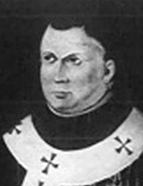

Several other titles were published at Impressão Régia, such as the funeral orations of the Bishop of Leiria and the Bishop-Count of Coimbra, in 1820 and 1822; and voluminous collections of anti-liberal pamphlets, virulent in tone and rich in political intolerance language, such as the periodicals O Punhal dos Corcundas [The Hunchback's Dagger] (1823-24), O Mastigóforo [The Mastigophora] (1824 and 1829), O Defensor dos Jesuítas [The Defender of the Jesuits] (1829-1833) and A Contra-mina [The Countermine] (1830), some of them during the reign of King Miguel and when Friar Fortunato was already Archbishop of Évora. In these writings, the author blended the finest anti-Masonic rhetoric with the authority of his public office positions, acting — like José Agostinho de Macedo and other writers — as an unofficial spokesperson for the regime against liberal thought. However, even during the liberal period and after the Vila-Francada, he refrained from inciting physical violence (especially in O Punhal dos Corcundas anonymous). He thus associates the concept of popular sovereignty and the actions of Freemasonry with errors in historical and philosophical logic, both of which he traces back to Luther’s Reformation and the 18th-century Enlightenment. During the Vintist triennium, he criticises royal legislation on ecclesiastical matters, the separation of Church and State, the attempts to reform the clergy, and freedoms of the press and thought. He defends the Inquisition and the Society of Jesus as forces countering the irreligiosity of the 16th and 19th centuries; he refrains from describing his own era as one of decadence, although he does criticise the alleged role of the Vintists in Brazilian independence and the depletion of public funds. Finally, he praises Bossuet and ultramontane thinking, showing a careful argumentative construction inspired by biblical examples and an informed, almost legalistic and moderate historian's view of the affairs of the State and the Church. In the second publication of O Mastigóforo from 1829 onwards, with King Miguel's royal position already strengthened, the language and tone change, much more aggressive and dichotomous, with no aim of leading to reflection or debate, but rather, "through the Manichaeism it reproduces, to provoke immediate feelings of near love/hate, repudiation/acceptance", following the line of thought of José Agostinho de Macedo, whom he calls the prince of anti-Masonic writers. Although he calls for a war of the pen rather than the sword, his tone is clearly warmongering and intolerant, in line with what he considered to be the teachings of the Holy Scriptures in the face of the heresies of all times. He starts to favour the extreme ideas of a Masonic conspiracy, as Abbé Barruel used to say (Marília Favinha, Frei Fortunato de São Boaventura e a “Contra-Revolução” [Friar Fortunato of St Bonaventure and the ‘Counter-Revolution’] , 1996, pp. 95-109, 117, 119, 121-131 and 143-147 and João Ameal, «D. Frei Fortunato de São Boaventura…», 1964, pp. 406-423 and 428-429).
This work is financed by national funds through FCT - Foundation for Science and Technology, I.P, in the scope of the projects UIDB/04311/2020 and UIDP/04311/2020.
